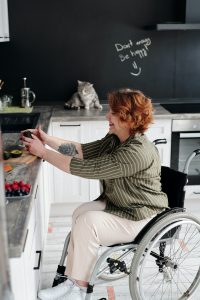 Physical problems that can cause immobility can happen to anyone. A fall can cause an leg to break or a serious condition can make a person wheel chair bound permanently. Painful conditions that limit movement, such as arthritis or back pain, actually respond well to physical exertion. It might seem that exercising is impossible, but that’s not so. There are exercises for reduced mobility that you can do while you’re on the mend or do to help keep you healthier, even if you are immobile. Even if you’re bed bound, you can still get the benefits and good feeling that comes with exercise.
Physical problems that can cause immobility can happen to anyone. A fall can cause an leg to break or a serious condition can make a person wheel chair bound permanently. Painful conditions that limit movement, such as arthritis or back pain, actually respond well to physical exertion. It might seem that exercising is impossible, but that’s not so. There are exercises for reduced mobility that you can do while you’re on the mend or do to help keep you healthier, even if you are immobile. Even if you’re bed bound, you can still get the benefits and good feeling that comes with exercise.
Make sure you get the okay from your health care professional and do appropriate exercises.
If you have a health condition, such as osteoporosis, swollen joints, chest pain, a history of blood clots or symptoms of an illness like a fever, make sure that’s included in the discussion when you speak with your health care professional, fitness coach or therapist. Don’t overdo at first. You can get the benefits of a 30 minute workout by dividing it into three ten minute sessions. In most cases, short sessions can speed circulation and help you to heal. Long sessions can cause stress, which impedes healing.
Upper body workouts are perfect for anyone that can sit upright in a chair.
Based on your physical limitations, the workout will vary. If you’ve broken a leg, do a work around and focus on upper body, but also use resistance bands to work your unbroken leg. For those who are frail and wheel chair bound, exercises can provide more mobility and help prevent pressure sores. Work on posture. Lift your arms to right angles, bend them at the elbow and attempt to open them up until you look like a goal post. Stretch as far back as you can, squeezing your shoulder blades together. If you can stand, practice squats. Make sure you have people to help. Act as though you’re going to sit and touch your bottom to the chair then move back to standing position.
You can do exercises laying in bed.
Lay flat on your back, keeping your legs straight. Slide one leg to the side as far as you can without causing you to bend at the sides. Your knees and toes should remain directly on top, pointed upward. Then pull the leg back toward the center and do the other. You can do others, like simply raising your arms in the air and clasping your hands, then lowering them directly down and outstretched and repeat. Just moving helps you get or stay moving.
- If you have access to a pool, it’s perfect for those who have limited mobility, unless you have a cast that’s not waterproof. Your buoyancy and the resistance of the water makes it perfect for all types of training.
- Join a group. There are wheelchair and seated exercise groups, including seated tai chi, which is a gentle, but quite effective exercise. These classes provide both exercise and companionship.
- Just tightening and relaxing muscles, as in isometrics, help keep the muscles strong. It’s one reason visualization helps athletes. They’re subconsciously tightening the muscle groups as they visualize the movement.
- We have personal trainers that can help you with a program that’s designed specifically for your needs and limitations. Make sure you disclose any medical problems you have and always get the green light from your health care professional first.
For more information, contact us today at LIV Fitness
